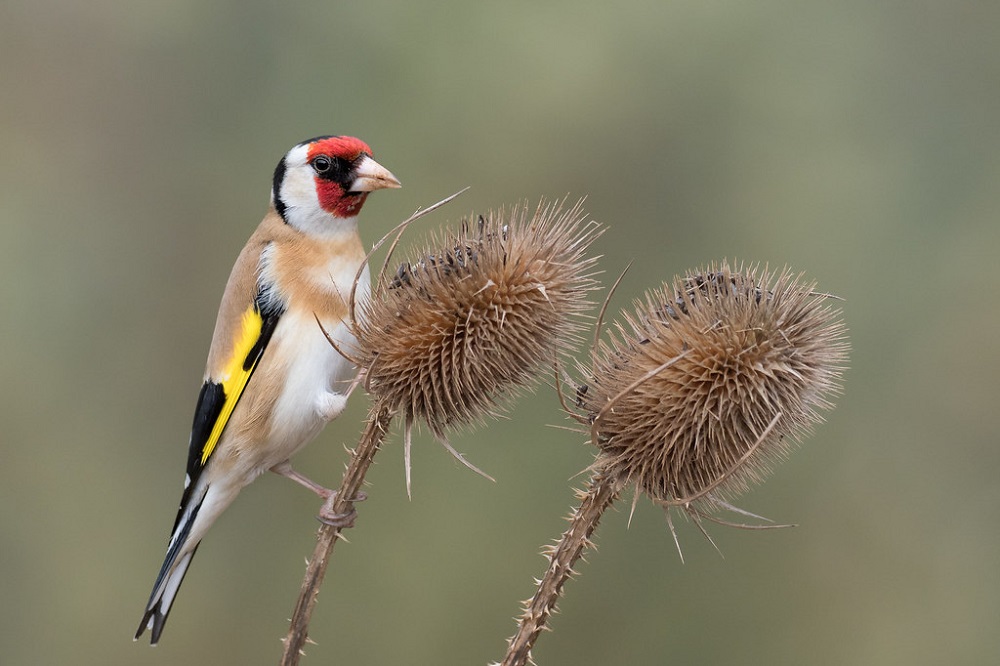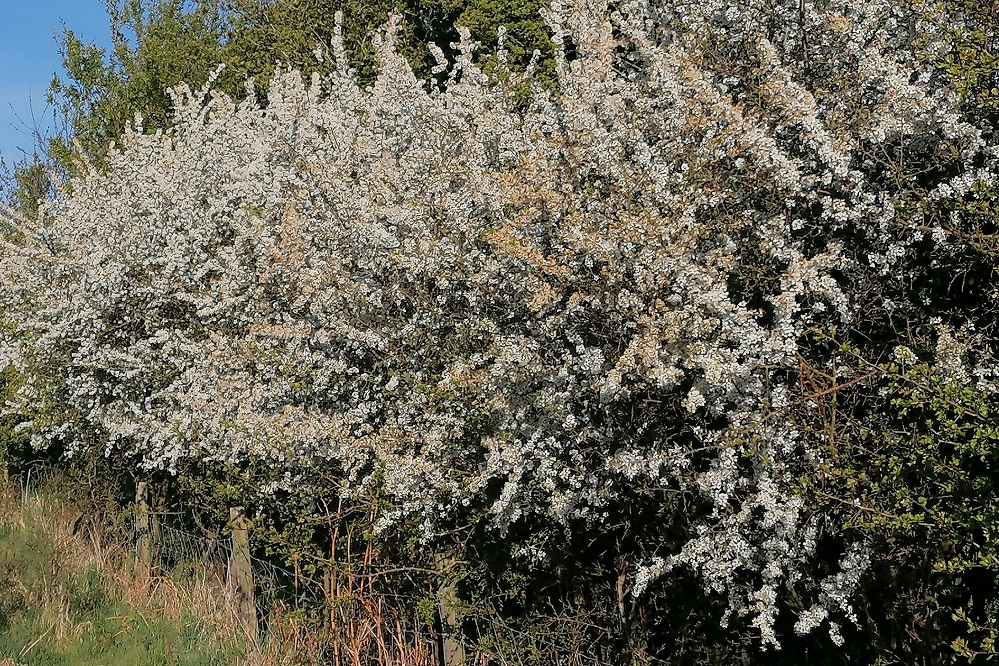Cynefin – A Sense of Place: Nests part two

Gaynor Funnell
If you walk further down the hedge line and follow it along the corner where it crosses Penrallt field, a nest the size of a Seville orange is half-hidden in a narrow tree near to the gate.
It’s the nest of a Goldfinch and nestles in the Vee of the only cherry-plum tree on the farm, sitting at the level of the hedge-cutting three years ago which is just above eye height.
The nest is cone shaped and made from thin stems, moss, grass and wool with a cup-centre that’s as smooth as a puddled pond.
This one has lichen around one edge, now flaking and dry, and although flowers are sometimes woven between the stems, there is no evidence of these now.
The female builds the nest in about a week and lays around five eggs of a clotted-cream colour with milk-chocolate specks. She alone will incubate them, but the male will turn up to help feed the young once they’ve hatched.
Goldfinch have slender bills adapted to eat seeds, although they will feed their young on insects such as aphids. Teasel and thistles are favourite foods although only the male can eat teasel seeds as his beak is slightly longer than the females.
One of its local names is Thisteltuige, an Anglo-Saxon name meaning thistle-tweaker, other names being Redcap and King Harry.
Redemption
Goldfinches are striking birds, with black and yellow wings, a buff-brown and cream body, a black head with white cheeks and a dipped-red face – legend says that the goldfinch tried to remove the thorns from the crown placed on Jesus’s head, the blood seeping into and permanently marking its face.
In Italian renaissance painting, the goldfinch was used as a symbol of Christian redemption and there are almost 500 paintings featuring the bird including Raphael’s Madonna of the Goldfinch which shows a young Christ reaching out to touch a goldfinch held by a young John the Baptist.
Its colouring and liquid-song call was the reason that many were trapped and kept as caged songbirds in Victorian times and they could also be trained to carry-out simple tricks, such as lifting a thimble full of water.
The decline in their numbers only halted when the Royal society for the protection of birds intervened and the population began to increase.
Finding a goldfinch nest in this field was unexpected. Perhaps the long grass left around the edges of the field and now sprinkled with the remains of creeping thistle have persuaded them to spread further.
In Autumn, they flock around the surrounding lane and the top fields near to the quarry where the ground is dry and the thistles, dock and orach run to seed more quickly – since I’ve not cut the verges the last two years, there are more of these particular plants.
Goldfinches are easy to identify with their vivid colouring and continuous peeping and twittering. They sometimes fly with linnets and redpolls, their yellow wing flashes blinking amongst the wave of red, gold and brown rippling through the long grasses.
Deception
The cherry plum in which the nest sits is a pretty tree in early spring. It’s the first tree to flower, beating the blackthorn by a couple of weeks.
In the Victorian language of flowers, the cherry-plum symbolises deception. The flowers are similar to blackthorn ; five white petals with a froth of primrose-yellow stamens in their centre, delicate stars of white sprinkled against the dark.
Whereas when the blackthorn comes into flower, the whole tree becomes submerged in an icing-sugar coating. A hedge line of blackthorn is a beautiful thing.
Cherry plums, or as they are sometimes known, Myrobalan plums, were often planted as a shelter belt for orchards – they have been traced back to the 1700’s – and although they can grow up to 20 feet, when pruned, they make a good, dense hedge being fast growing and suitable for coastal and windy areas, such as here in Penrallt field, where the wind from the sea blows straight across the valley.
Cherry plum is used in Bach’s flower remedies as a remedy for people in fear of losing control, including hurting others or themselves, or acting irrationally. Cherry plum essence can be used to give you the courage to follow your own path.
It is one of the five flowers used for Dr Bach’s Rescue remedy, a mix created to deal with immediate emergencies and crises, the others being star of Bethlehem, rock rose, impatiens and clematis. It is also recommended to take before exams,
As a homeopathic practitioner, Dr Edward Bach travelled through Wales and the UK between 1930 and 1934 to research flowers he believed would provide a safe and natural method of healing.

Folklore
This cherry plum is growing in my favourite hedge on the farm, favourite because there are many different varieties of plants entwined along it.
Blackthorn and hawthorn are the two stalwarts and are both stunning in spring and autumn, especially now since nothing has been pruned for three years.
There is also a spreading sycamore, goat willow, hazel, elder, a field maple (the only one on the farm and which turns a burning crimson, madder and butter-yellow in the autumn) and three wild cherry trees.
These bear drifts of white flowers in April which appear before the leaves like blackthorn, and clusters of small yellow-red berries in August – not that you get to see a lot of them as the blackbirds enjoy eating them.
I found a missed cluster once – the fruit is smaller and has a more bitter taste than the cultivated variety.
The cherry trees bark is a rough, russet-brown with horizontal bands and can peel off in strips and the wood is considered useful for furniture making and turning. The first spoon I made was out of cherry wood, the colour resembling that of a freshly-hatched conker.
In folklore, a cuckoo has to eat three good meals of cherries before it stops singing.
They must have eaten bushels of fruit here, as I have never heard or seen one on the farm.
Gaynor Funnell is the winner of the Nigel Jenkins award for 2022. We are delighted to be publishing a series about Penbanc over the coming months, with support from the H’mm Foundation.
You can read the serialisation so far here and you can discover other writing by Gaynor on Nation.Cymru by following her link on this map
Support our Nation today
For the price of a cup of coffee a month you can help us create an independent, not-for-profit, national news service for the people of Wales, by the people of Wales.






